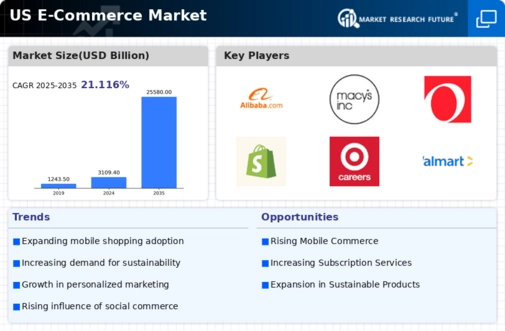Expansion of Payment Options
The e commerce market is witnessing a significant expansion in payment options, which is likely to enhance consumer convenience and drive sales. With the rise of digital wallets, cryptocurrencies, and buy-now-pay-later services, consumers are presented with a variety of payment methods that cater to their preferences. Recent statistics suggest that nearly 60% of online shoppers abandon their carts due to limited payment options. By offering diverse payment solutions, businesses can potentially reduce cart abandonment rates and increase overall sales. Additionally, the integration of secure payment gateways is fostering consumer trust, as security remains a top concern for online shoppers. As more payment options become available, the e commerce market is poised for growth, as it aligns with consumer expectations for flexibility and security in transactions.
Growth of Subscription Services
The e commerce market is experiencing a notable rise in subscription services, which are reshaping consumer purchasing behaviors. This model offers consumers convenience and value, as they receive products on a regular basis without the need for repeated transactions. Data shows that subscription box services have grown by over 20% annually, indicating a strong consumer interest in curated experiences. This trend is particularly prevalent in sectors such as beauty, food, and fashion, where consumers appreciate the novelty and personalization that subscriptions provide. As businesses continue to innovate within this model, the e commerce market is likely to benefit from increased customer loyalty and predictable revenue streams, making it a compelling strategy for growth.
Increased Focus on Customer Experience
The e commerce market is increasingly prioritizing customer experience as a key driver of growth. Companies are investing in user-friendly website designs, efficient customer service, and streamlined checkout processes to enhance satisfaction. Research indicates that 80% of consumers are more likely to return to a site that offers a seamless shopping experience. This focus on customer experience is not merely a trend; it is becoming a fundamental aspect of business strategy. Moreover, the rise of social commerce, where social media platforms facilitate shopping, is further emphasizing the need for an engaging customer journey. As businesses adapt to these evolving expectations, the e commerce market is likely to see improved customer retention and higher sales volumes, as satisfied customers are more inclined to make repeat purchases.
Technological Advancements in E Commerce
The e commerce market is currently experiencing rapid technological advancements that are reshaping consumer interactions. Innovations such as artificial intelligence (AI) and machine learning are enhancing customer experiences through personalized recommendations and improved search functionalities. According to recent data, approximately 70% of consumers prefer personalized shopping experiences, which indicates a strong demand for tailored services. Furthermore, the integration of augmented reality (AR) is allowing customers to visualize products in their own environments before making a purchase. This trend is likely to drive sales, as it reduces uncertainty and increases consumer confidence. As technology continues to evolve, the e commerce market is expected to leverage these advancements to create more engaging and efficient shopping experiences, ultimately leading to increased customer loyalty and higher conversion rates.
Emphasis on Sustainability and Ethical Practices
The e commerce market is increasingly emphasizing sustainability and ethical practices, reflecting a growing consumer demand for responsible shopping. Recent surveys indicate that over 70% of consumers are willing to pay more for products from environmentally conscious brands. This shift is prompting businesses to adopt sustainable sourcing, eco-friendly packaging, and transparent supply chains. As consumers become more aware of their purchasing impacts, companies that prioritize sustainability are likely to gain a competitive edge. Furthermore, the integration of sustainability into marketing strategies can enhance brand loyalty and attract a broader customer base. As this trend continues to evolve, the e commerce market is expected to see a transformation in how products are marketed and delivered, aligning with consumer values and expectations.

















Leave a Comment